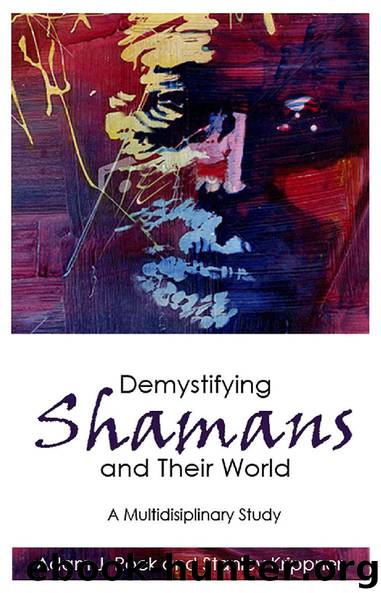Demystifying Shamans and Their World by Adam J. Rock & Stanley Krippner

Author:Adam J. Rock & Stanley Krippner
Language: eng
Format: epub
Tags: shamans, shamanism, spirit world, healing, states of consciousness, mental imagery, 10-facet model, psycology, shamanic imagery
ISBN: 9781845403324
Publisher: Andrews UK Limited 2011
Published: 2011-10-14T00:00:00+00:00
Chapter Six: The Construction of an Ontology and Epistemology of Shamanic Journeying Imagery
An integral feature of shamanism is the utilisation of “… techniques for inducing, maintaining, and interpreting the experience of enhanced visual mental imagery” (Noll, 1985, p. 45). Indeed, Peters (1989) stated that, “The shaman is a visualiser …” (p. 130), who relies on this modality to access transpersonal realms. In support of this contention, Houran, Lange, and Crist-Houran (1997) analysed 30 phenomenological reports concerning shamanic journeying, derived from Harner (1980), and found that 93.3% emphasised visual phenomena. Shamanic visualisations (i.e., journeying imagery) typically reflect one’s cultural cosmology (Krippner, 1990b; Walsh, 1995, 2007), which tends to be a multi-layered universe consisting of an upper world, middle world (the terrestrial world or Earth), and lower world (Ellwood, 1987). [1] Sometimes there are several upper worlds or lower worlds, and the inhabitants of these realms are not consistent across cultures.
In recent years, shamanic practices have generated increasing interest as a complementary therapeutic strategy in the conventional medical and psychological arenas (Bittman et al., 2001; DuBois, 2009, pp. 264–290). Consequently, it may prove prudent to investigate further the nature of shamanic patterns of phenomenal properties (e.g., journeying imagery). At the same time, to our knowledge, a lacuna exists in the literature with regard to a systematic analysis of the philosophical problems hampering the development of an ontology and epistemology of shamanic journeying imagery. This is crucially important at a time when neo-shamanism has made purported “shamanic journeying” available to neophytes. Traditional shamans may or may not report imagery similar to that reported by well-meaning but poorly-seasoned neo-shamanic practitioners.
Ontology may be defined as “the matter of what there is in the world” (Chalmers, 1996, p. 41); it is concerned with “an overall conception of how things are” (Heil, 1998, p. 6). The term “ontological foundations” refers to the fundamental nature or essence of a particular variable, X (e.g., a shamanic journey image). For example, an ontologist might be concerned with whether the kind of “thing” that a shamanic journeying image is referentially linked to is imaginal (e.g., derived from material stored in one’s long-term memory system) or transpersonal (i.e., independent of the percipient’s mind-body complex) (Walsh, 1990a).
In contrast, epistemology may be defined as the study of the “origins, nature, methods and limits of human knowledge” (Reber & Reber, 2001, p. 246). With regard to shamanic patterns of phenomenal properties, one might, for example, investigate the epistemic process that results in a percipient becoming aware of a shamanic journeying image. While epistemological debates in the philosophy of religion have tended to focus on mystical experience (e.g., Evans, 1989; Forman, 1996; Gill, 1984; Katz, 1978, 1983; Stoeber, 1991), one might contend that the epistemological problems discussed are also applicable to shamanic patterns of phenomenal properties. For example, there is no reason in principle why the epistemological issue of whether mystical experience is “shaped” conceptually and linguistically by one’s cultural milieu is not applicable to shamanic patterns of phenomenal properties. Indeed, a recent series of papers (e.
Download
This site does not store any files on its server. We only index and link to content provided by other sites. Please contact the content providers to delete copyright contents if any and email us, we'll remove relevant links or contents immediately.
Becoming Supernatural by Dr. Joe Dispenza(8127)
Crystal Healing for Women by Mariah K. Lyons(7857)
The Witchcraft of Salem Village by Shirley Jackson(7196)
Inner Engineering: A Yogi's Guide to Joy by Sadhguru(6728)
The Four Agreements by Don Miguel Ruiz(6641)
The Power of Now: A Guide to Spiritual Enlightenment by Eckhart Tolle(5610)
Secrets of Antigravity Propulsion: Tesla, UFOs, and Classified Aerospace Technology by Ph.D. Paul A. Laviolette(5311)
The Wisdom of Sundays by Oprah Winfrey(5087)
Room 212 by Kate Stewart(5041)
Pale Blue Dot by Carl Sagan(4917)
Fear by Osho(4663)
The David Icke Guide to the Global Conspiracy (and how to end it) by David Icke(4629)
Animal Frequency by Melissa Alvarez(4399)
Rising Strong by Brene Brown(4382)
How to Change Your Mind by Michael Pollan(4293)
Sigil Witchery by Laura Tempest Zakroff(4181)
Real Magic by Dean Radin PhD(4077)
Man and His Symbols by Carl Gustav Jung(4070)
The Art of Happiness by The Dalai Lama(4065)
